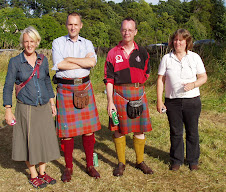I chickened out on the television. It's
so hard to judge size in a shop – not how big something actually
is, that's easy, but how big it will seem in the room. I measured
hospital televisions yesterday instead, not without profit. The one in my
husband's room is the same size as the one we have here. The one in
the Day Room is much bigger, too big. I need something in between. I
might go up to John Lewis this morning.
I think I'm set fair for the wedding. If they phone next week to say that my
husband can be released, I can say, Great! let's arrange everything
for Monday the 21st. There will be lots of arranging to
do.
I made a good start on the sleeveless
vest yesterday. Only a round or two more, and the tedious ribbing
will be at an end. There's a suitable basic vest in “Knits Men
Want” – the book that provided the pattern for Archie's sweater –
which will be a useful supplement to the inadequate notes I made
while knitting the first one.
Soon I will have to
increase. The ribbing is done on 90% of “K”. Somewhere Meg has a
rather fun formula for calculating increases, and I think I know
where to find it. But I found this Knitulator
via Facebook. It's quicker and easier, and just as much fun.
I don't know Eskimimi (the authoress of
the Knitulator). I like her. The baby jacket she links to in the
Knitulator page I've linked you to, is delightful. It's not entirely her
own design, but her own take on it is very good. It's called Langoz.
Not easy to remember. I've put it in Evernote.
And speaking of blogs, thank you,
Peggy, for straightening me out on Franklin
and his new Skacel blog. I've now subscribed to it. It's clearly
going to be very different from what he writes for Lion Brand. I heard
someone say “Skacel” out loud on a video clip on my iPad this
morning – there was a totally unexpected emphasis on the final
syllable.
I am enormously touched by your suggestion of all chipping in to knit the squares and triangles of the Dunfallandy blankie. A problem would be the patchwork of yarns, when I have ordered all that expensive stuff from Loop. But also I want to do this myself, for this first great-grandchild. But thank you, thank you, and thank you.
I am enormously touched by your suggestion of all chipping in to knit the squares and triangles of the Dunfallandy blankie. A problem would be the patchwork of yarns, when I have ordered all that expensive stuff from Loop. But also I want to do this myself, for this first great-grandchild. But thank you, thank you, and thank you.
Evolution
I struggle on. Dawkins was no use – I
resorted to speed-reading towards the end and have now happily
archived it. He talks interestingly enough about the many curious
adaptations shewn in nature and in fossils. But there is only an
off-hand sentence about speciation –populations move away from each
other and go on evolving until their genomes are so different that
interbreeding is impossible. Yes, obviously, that's what must happen.
But how does it work, on the genome level? How do you evolve (for
instance) a different number of chromosomes from your parents?
Alas, Ridley's “Genome” is not
available for the Kindle, and I can't find my copy.
Someone has written a book called
Speciation, but a) it sounds difficult and b) it's very expensive and
c) it's not available for the Kindle, either.



Perhaps for reading you could shift to history. I was recommended "The Island at the Centre of the World" by Russell Shorto. It's a history of New York and I thought of you when friend recommended it. She found it fascinating.
ReplyDeleteI can't put my hand out and find my copy of "Genome" or I would pop it in the post to you! Let us know if yours comes back to heel, and I will keep my eyes open for mine, just in case.
ReplyDeleteI am so glad you feel able(ish) and want to knit the blanket yourself. All the help in the world would prevent it from being a properly Great-Grandmotherly heirloom.
We just bought a flat screen TV. Because we have three cats the stability of the stand was crucial but even then, my husband drilled several holes into the top of the wooden TV unit and we zip tied the stand to the top of the TV unit. Within 24 hours Max All 5kg of him) tried to leap onto the top of the TV, wobbled dangerously as the TV tried to fall over and then slid down the front of the screen, no doubt killing a few pixels as his claws scrabbled for grip.
ReplyDeleteBut the TV would have been face down on the floor if it hadn't been zip tied down.
I merely mention this as an anti-Perdita warning. Get a TV that can be firmly fixed into a solid and weighty base.
We bought a 40" screen btw. Once up we realised it was exactly the same size as our old brick TV, except of course it was all screen rather than a 26" screen fitted into a huge box. So it doesn't look any more intrusive in the room than the old one.
Yup, make sure the TV is either a) sturdily attached to a wall (the flatscreens are much lighter than you'd think given their size but I'd still get someone who knows in), or b) a sturdy stand or table.
ReplyDeleteIn our case we decided to channel our local rednecks and put the new flatscreen on top of the old wooden box TV. (That might have something to do with the old TV far exceeding my lifting capabilities, though the new one's about 25 pounds or so, just awkward because of size.)
As for the "how do you evolve...?" question, I believe (please remember my degree's in physics, not evolutionary biology) they start out as mistakes as cells divide. If the mistake happens in a reproductive cell (egg or sperm) that is then used, well, you either get a new being with problems, no being at all, or a being who's lucked into a happy accident. (The second's the most likely) Happens in the human population (Down's syndrome for example). Interestingly enough, the Y chromosome has lost more and more of itself over our evolution (wish I could remember why, but all I really remember is looking at a picture of a normal X next to a normal Y and being amazed at the difference).
A 32" screen would probably do you. Those big ones in the hospitals are usually 40"/42" upwards. John Lewis would put you right about it.
ReplyDeletethe other option for a flat screen tv is one that i have done = the tv is housed in my entertainment armoire. Isolde (the one who jumps) loves to hang out on top of the armoire- she has a dish of food and a knitted blankie and most important, Emil can not jump being too big (and he never was a jumping cat).
ReplyDeleteIf you dont have an armoire the other idea is to take out a couple of shelves in a bookcase - the depth of the flat screens are such that they would fit . and in that case i would tie the screen down as it would be more accessible to little kittens exploring...
when i upgraded to a flat screen i measured very carefully and the one i purchased fits with just 1 inch around the opening of the tv self in the armoire (it was designed as an entertainment armoire). if you visit instagram or flickr you will see photos of it (i recently painted it all black ... the bookcases are to be painted as soon as it cools off enough that i can open the windows.)
sogalitno at both places.
i love my flat screen and would like a larger one (this is 32) but would have to chop the armoire in many pieces to remove it and design another shelving solution (the landlord closed up the only large door so removing this if i ever move will mean destroying it sigh).
anyway, did you watch any of the Womens finals at the US Open today? INcredible story and amazing women - it was a joyous and tearful occasion.
Roger v Nola sunday at 4 pm ... will be quite a match considering that Roger is playing the best tennis in five years and maybe the best ever. go roger!
Hello! I've just rediscovered your blog after many years away, and was delighted to see that you are reading about evolution, my profession. The question of speciation that you are wrestling with was a puzzle for biologists for many years as well, and for exactly the same reason. That is, how can something that makes hybrids dead or sterile evolve?
ReplyDeleteThe current working model is that at least 2 factors are involved, and it is the combination of them that causes the problem. As an example-- imagine that evolution proceeds by replacing one gene variant with another, i.e. 'a' is replaced by 'A', 'b' by 'B', etc. So, you might have single substitutions in each population:
population 1: ab-> Ab
population 2: ab-> aB
Note that the populations start the same, and that ab, Ab, and aB are all viable genotypes. BUT, the AB combination might not be-- it has never had to work in any one population, and it might be fatal.
I hope this answers your question, but I'm happy to explain further if not. It's not always easy to convey things clearly even to an intelligent audience when you are used to talking to other people in the field, who speak a common language. Speaking of, these are 'Dobzhansky-Muller incompatibilities', if you'd like a search term. Some have been defined molecularly.
Cheers,
Andrea